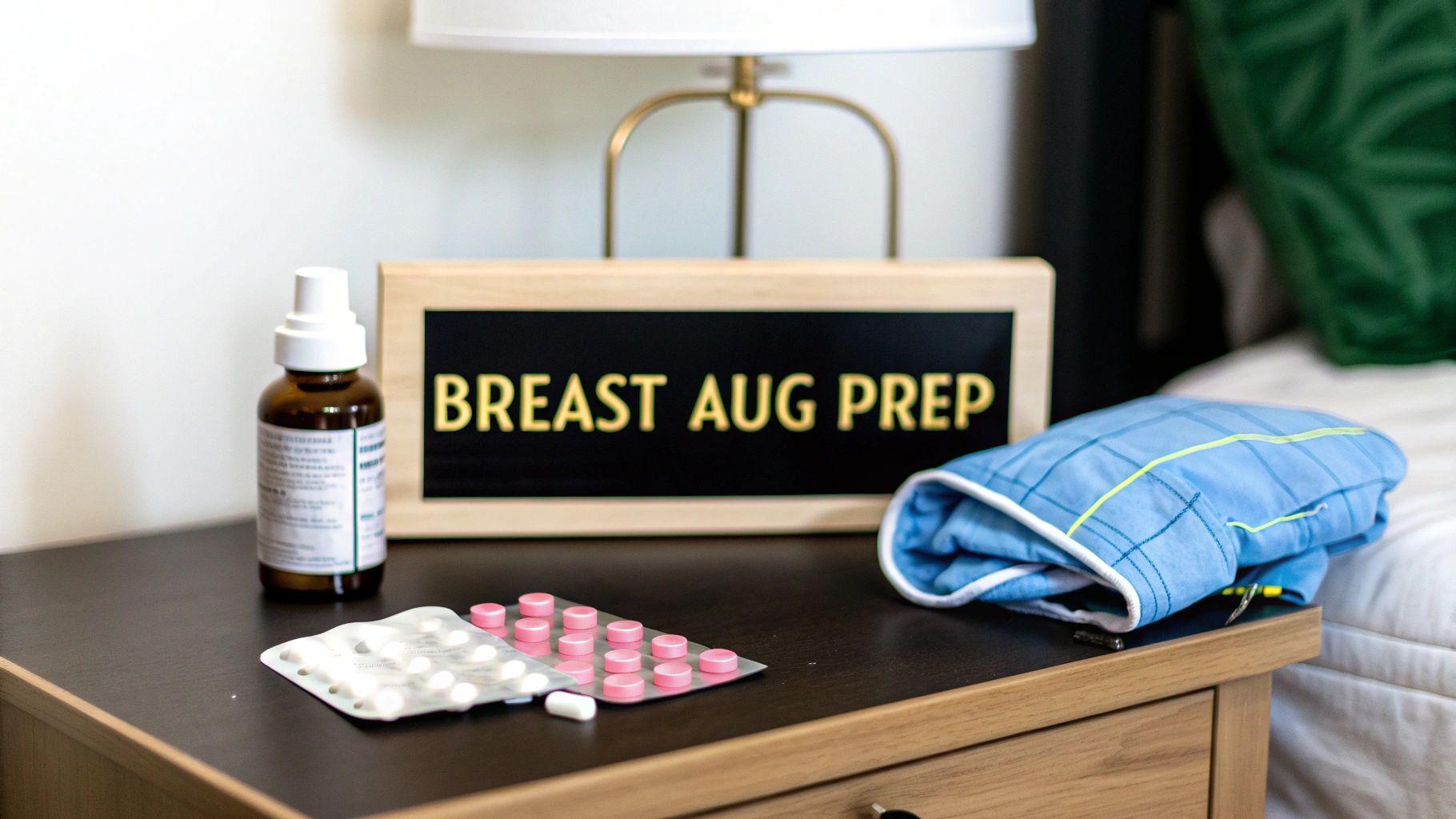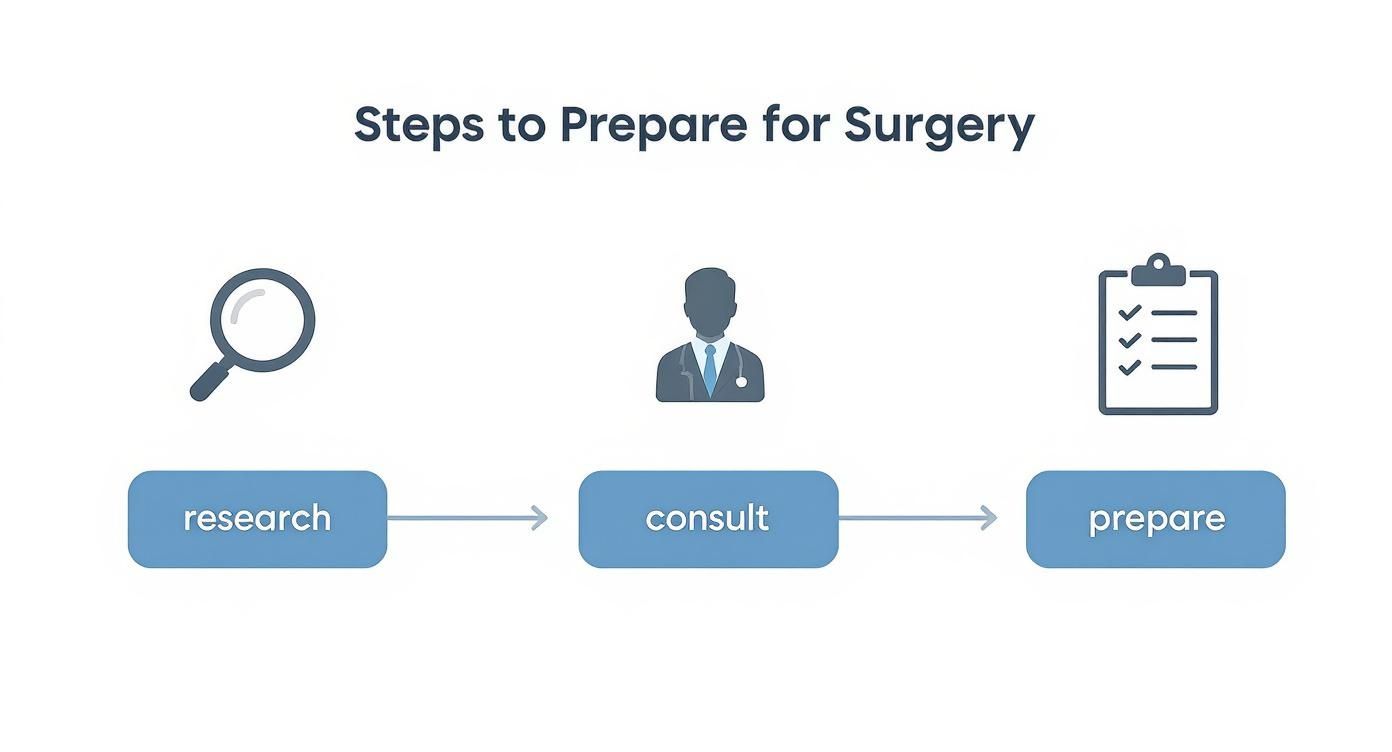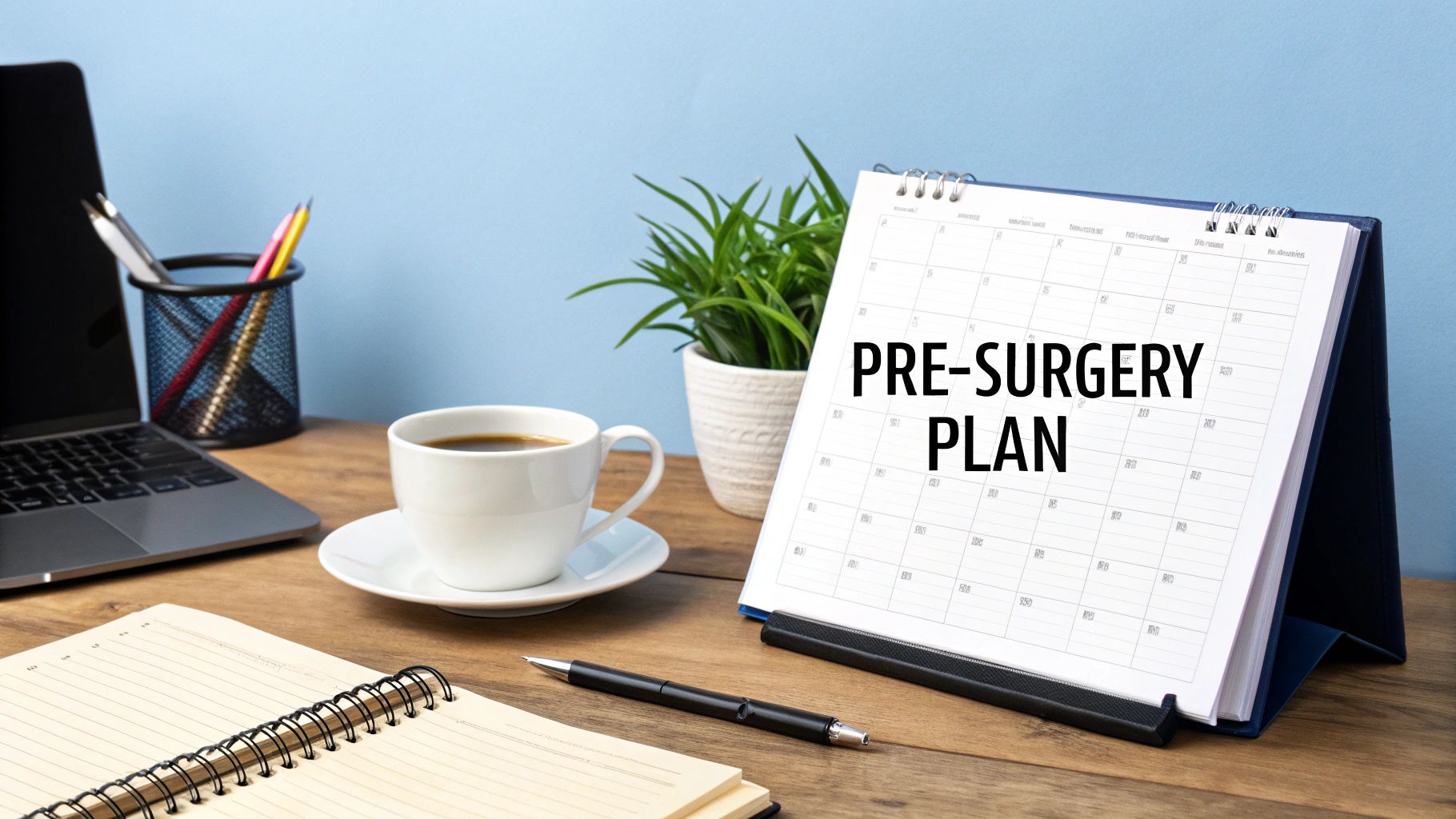
December 22, 2025
Chemical Peel for Dark Circles: The Ultimate Guide to Brighter Eyes
Discover how a chemical peel for dark circles can refresh under-eye skin, what to expect, risks, and tips for safe, glowing results.
Nov 7, 2025

Getting ready for breast augmentation is much more than just showing up on surgery day. It’s a journey with a few distinct phases, all designed to make sure you’re confident, healthy, and fully prepared for a smooth procedure and an even smoother recovery.
Think of it as your personal pre-surgery blueprint. It starts with learning everything you can, moves into making concrete decisions with your surgeon, and ends with getting your body and your home ready for the big day.
A solid plan is your best friend here. It helps you stay organized and feel in control, turning what could be an overwhelming process into a series of manageable steps. When you know what to expect, you can focus on the exciting outcome ahead.
This timeline gives you a great overview of what the process looks like from start to finish.

As you can see, each phase builds on the one before it, leading you right up to your procedure date without any last-minute surprises.
You'll start with broad research—looking at surgeons, implant types, and before-and-after photos—and slowly narrow your focus to the details that are specific to you. This is a path millions of women have walked before; in fact, over 1.89 million breast augmentations are performed worldwide each year, so the preparation protocols are incredibly well-established.
To help you map everything out, here's a look at the key preparation phases.
This table breaks down the critical stages of preparation, outlining the timeline and primary focus for each phase to help you stay organized.
By breaking it down like this, the process becomes much less daunting. You can focus on one phase at a time.
As you move through your timeline, you'll hit a few major milestones that need to be checked off your list:
Tackling these things one by one prevents that last-minute scramble. When everything is handled ahead of time, you can walk into your surgery feeling calm, prepared, and ready for a great result.
Think of your consultation as the most critical conversation you'll have on your breast augmentation journey. This isn't just a quick chat or a formality; it's a deep-dive session where your aesthetic vision meets your surgeon's hands-on expertise. It's the moment your ideas start turning into a real, tangible plan for your body.

To get the most out of this time, you need to come prepared for an open and honest talk. Your surgeon needs the full story to keep you safe and get you the results you’re dreaming of. This means sharing everything—your complete medical history, your daily habits, and exactly what you hope to see in the mirror post-surgery.
This is the one area where you can't hold back. Keeping quiet about certain medications, a smoking habit, or old health problems can introduce serious risks. Your surgeon isn't there to pass judgment. They're your partner, and their primary goal is a safe procedure and a fantastic outcome for you.
Put it this way: the more your surgeon knows, the more customized your surgical plan can be. Something as simple as a supplement you take could affect bleeding, or a previous surgery might change how your body heals. Every detail matters.
Your consultation is your time to ask anything and everything. Don't be shy—this is a major decision about your body and a significant investment. The choices made in this meeting will shape your results for years.
Be ready to talk through the specifics with your surgeon:
My Advice: Treat your consultation as the cornerstone of your entire experience. Come with your questions written down, be an open book, and see your surgeon as your collaborator. A well-informed patient is always a more confident one.
Making these calls can feel like a lot, but a good surgeon will walk you through it. Many of us now use 3D imaging technology in our clinics, which is a game-changer. It lets you see a surprisingly realistic preview of how different implant choices will look on your body, helping align what you want with what's surgically achievable.
Choosing the right implant size is less about a cup size and more about finding a balanced, proportional look that fits your unique frame. While your personal taste is what matters most, it helps to know where the trends are heading.
We've seen a huge shift in the breast augmentation world toward more natural-looking outcomes. Patients are increasingly choosing smaller implants that create harmony rather than just size. Years ago, implants in the 350–400cc range were common for a more dramatic look. Today, many women are opting for sizes in the 250–300cc range, and sometimes even smaller, for a subtler enhancement.
This is a deeply personal choice, of course. A good breast implant size guide can give you more context before your appointment. Bringing "wish pictures" is also incredibly helpful, but here’s a pro tip: find photos of people who have a similar body frame to yours. This gives your surgeon a much clearer visual of the aesthetic you're after.
In the end, your surgeon will make their final recommendations based on your unique anatomy—your chest width, the amount of breast tissue you have now, and your skin's elasticity. When you show up prepared and ready to collaborate, you and your surgeon can confidently create a surgical plan that truly brings your vision to life.
Getting ready for breast augmentation is about more than just scheduling the day off work. It’s a holistic process. To get the fantastic, long-lasting results you want, you need to prepare your body and your mind for what’s ahead. A healthy body heals faster, and a calm, prepared mind makes the entire experience smoother.
Think of it as training for a big event—because it is.

Your body is about to do some serious work, and it needs the right fuel. In the weeks leading up to surgery, focus on giving it the building blocks for tissue repair and a strong immune system. That means a diet packed with vitamins, minerals, and especially protein.
Protein is the star player here; it's essential for creating new cells and collagen, which are critical for healing your incisions. I always tell my patients to try and get a good source of lean protein with every meal.
Some great options include:
Hydration is equally important. Water is your best friend before and after surgery. It helps flush out toxins, gets nutrients where they need to go, and can even help with post-anesthesia side effects like constipation. Try to keep a water bottle with you and sip on it all day long.
This part is non-negotiable. You absolutely must review every single medication and supplement you take with your surgeon. So many common, over-the-counter products can thin your blood or interfere with anesthesia, which is a serious safety risk.
Your surgeon will give you a detailed list, but you’ll almost certainly need to stop taking the following at least two weeks before your surgery:
Crucial Takeaway: Never, ever stop taking a prescribed medication without talking to your doctor first. Your surgical team will give you crystal-clear instructions on what to pause and when. Your safety is always the top priority.
Some daily habits can seriously get in the way of a smooth recovery. The two biggest culprits I see are smoking and alcohol.
Nicotine is a major problem because it constricts blood vessels, choking off the blood supply to your healing tissues. This can lead to devastating complications, from delayed healing and infection to tissue death. You must quit all nicotine—cigarettes, vapes, patches, everything—for at least four to six weeks before and after surgery.
Alcohol isn’t great either. It dehydrates you, can thin your blood, and mixes poorly with anesthesia and pain meds. It’s best to cut it out completely for one to two weeks before your surgery to give your body the best possible fighting chance.
Before we dive into mental readiness, here's a quick cheat sheet to help you stay on track.
This simple checklist breaks down the essentials for the weeks leading up to your procedure, helping you focus on what truly matters for a safe and successful outcome.
Following these guidelines is a practical way to take control of your health and set the stage for a great recovery.
The physical prep is only half the battle. It's completely normal to feel a rollercoaster of emotions—excitement one minute, nerves the next. The key is to acknowledge those feelings and have a plan to manage them.
First, set realistic expectations. Your breasts won’t look perfect the day after surgery. They’ll be swollen and sit quite high on your chest. It takes several months for them to "drop and fluff" into their final, natural-looking position. Patience is your best friend during this phase.
Lean on your support system. Tell your designated caregiver what you're worried about and what kind of help you’ll need. Creating a simple daily self-care checklist can also be a wonderful tool to keep you grounded and ensure you’re taking care of yourself from all angles.
The global market for breast implants, recently valued between USD 2.6 billion and USD 3.45 billion, is only growing. This isn't just a trend; it reflects the procedure's high satisfaction rate when patients are well-informed and prepared. Silicone implants, in particular, lead the market because of the beautiful, natural feel they provide.
By taking the time to prepare both your body and mind, you’re not just hoping for a good outcome—you’re actively creating the foundation for one.
A great recovery doesn't just happen by chance; it's the result of smart planning. One of the best things you can do for yourself is to turn a corner of your home into a dedicated recovery space before your surgery. This isn't just about tidying up a room. It's about strategically creating a comfortable, functional zone where your only job is to rest and heal.
Think of it as your personal healing nest. When you get home, you'll be tired, sore, and not moving around very easily. The last thing you’ll want to do is hunt for a phone charger or strain to reach a glass on a high shelf. Setting this space up ahead of time is a true act of kindness to your future self.
Having the right supplies within arm's reach can be the difference between a smooth recovery and a frustrating one. Before your surgery date, make a special trip to the store or place an online order for everything you might need. Getting this done early means you’ll have all the essentials ready the moment you walk through the door.
Your list should be a mix of comfort items, practical clothing, and any necessary medical supplies.
Here’s what I always recommend to my patients:
Pro Tip: Set up a small bedside table or caddy right next to where you'll be resting. Stock it with everything you need for 24 hours: your meds, water, snacks, phone, lip balm, and the TV remote. This tiny bit of prep saves you from having to get up and down constantly.
For an even more comfortable recovery, many patients find it helpful to be considering an adjustable bed. It can make finding that perfect, supportive resting position much easier, which is fantastic for managing post-op swelling and discomfort.
Cooking will be the absolute last thing on your mind after surgery. By stocking your kitchen ahead of time with easy-to-digest, simple-to-prepare foods, you’ll ensure your body gets the fuel it needs to heal without any extra stress.
Focus on foods high in protein and fiber but low in sodium. Too much salt can make swelling worse, and fiber helps combat the constipation that often comes along with anesthesia and pain medication.
Have these kinds of items on hand:
And don't forget your prescriptions! Make sure you fill them a few days before surgery. This includes your pain medication, any antibiotics, and the stool softeners your surgeon recommends. Having them ready at home avoids a last-minute, stressful pharmacy run for your caregiver.
The friend or family member helping you is your most important recovery partner. They want to help, but they aren’t mind readers. The best way to set them (and you) up for success is to have a calm, clear chat before the big day.
Walk them through your recovery space and show them where you've put everything. I also suggest creating a simple, one-page info sheet with all the crucial details.
Your Caregiver's "Cheat Sheet" Should Include:
This little bit of prep work empowers your caregiver to help you with confidence. More importantly, it frees you up to focus completely on healing—which is exactly where your energy should be. To get a clearer picture of what the healing journey entails, take a look at a detailed breast augmentation recovery timeline to help set realistic expectations.
When your surgery date is no longer weeks away but just around the corner, your focus naturally shifts. The big-picture planning is done; now it’s all about the final, crucial details. These last 48 hours are dedicated to personal care, final checks, and getting yourself into a calm, ready headspace. Following your surgeon's instructions to the letter during this period is non-negotiable—it's absolutely essential for your safety and a smooth procedure.

This final stretch should feel pretty straightforward. You’ve already done the heavy lifting by setting up your recovery nest and lining up your support system. Now, you’re just carrying out the last few steps of the plan. The goal is to walk into the surgical center feeling organized, confident, and ready for the positive change ahead.
Think minimal and practical. You really won’t need much for a same-day procedure, so the goal is to pack for comfort and convenience, not an overnight stay.
Here’s a simple checklist of what to throw in your bag:
That’s really it. Leave the jewelry, valuables, and even your contact lenses at home. Simplicity is your friend here.
Your surgeon will give you very specific instructions for showering, and this isn’t just about being clean—it’s a critical step in preventing infection. Think of it less as a regular shower and more as a key part of your medical prep.
Most protocols involve washing with a special antiseptic soap, like Hibiclens, both the night before and the morning of your surgery. You’ll want to pay close attention to your chest and underarm areas. Just be careful to avoid getting the soap on your face or any sensitive genital areas.
This is Crucial: On the day of your surgery, your skin needs to be a completely clean slate. That means no lotion, deodorant, perfume, or makeup. Nothing. These products can harbor bacteria or, in some cases, interfere with the monitoring equipment used during anesthesia.
Think of it this way: you’re providing a clean canvas for the surgical team. It’s a simple but powerful way to contribute to the safest possible environment for your procedure.
Of all the pre-op instructions, the fasting rules are arguably the most important ones to follow. An empty stomach is vital for anesthesia safety. When you're under anesthesia, your body's normal reflexes are suppressed. If there's food or liquid in your stomach, it could potentially come back up and get into your lungs—a serious complication called aspiration.
Your surgeon will give you a hard stop time, usually around midnight the night before surgery. After that, you can't eat or drink anything. And "anything" means anything—no water, no chewing gum, no breath mints. It can be tough, I know, but it is a non-negotiable safety measure. If you break the fast, your surgery will almost certainly be postponed.
The evening before surgery is your last chance to tie up loose ends and, hopefully, get a good night's sleep. Running through a final checklist can do wonders for a nervous mind.
Your Final To-Do List:
By taking care of these final steps, you're not just a patient; you're an active participant in your own success. You’ve done the research, made the big decisions, and prepared your home and your body. Now you can walk in on surgery day knowing you’ve done everything in your power to set the stage for a fantastic outcome.
As you get closer to surgery, it's natural for questions to pop up. Think of this as your go-to FAQ, where we tackle the common things patients ask, making sure you feel completely prepared and confident for the big day.
The sooner, the better, but a good rule of thumb is to start the ball rolling at least 2-3 months before you’d ideally like to have surgery. This gives you plenty of breathing room to do your research, meet with a few surgeons, get your financing in order, and schedule everything without feeling frantic.
The real hands-on prep, however, usually starts about 4-6 weeks out. This is your window to make those crucial lifestyle tweaks. For example, if you smoke or use any nicotine products, you'll need to stop at least a month beforehand. It's a non-negotiable step for ensuring your body has the healthy blood flow it needs to heal well.
A comfortable recovery is all about planning ahead. Having a few key items ready to go can make a huge difference in how you feel those first few days.
Here’s a quick checklist of what I always tell my patients to get:
Setting up your little recovery nest ahead of time is one of the best things you can do for yourself—and for whoever is helping you out!
This is a firm "no." You absolutely must have a trusted adult with you for at least the first 24-48 hours after surgery. This isn't just a suggestion; it's a strict safety requirement. Anesthesia is powerful stuff, and it takes a while to fully wear off, affecting your judgment and coordination. Driving is completely out of the question.
Your caregiver is your lifeline during this time. They'll help you get around, make sure you take your medications on time, fix you a snack, and just be there to keep an eye on things. Trying to go it alone in this initial period simply isn't a safe or realistic plan.
Your caregiver for the first day or two is an essential part of your safety net. Their job is to handle the practical stuff so you can focus 100% on resting and starting the healing process.
Getting medical clearance is a standard—and important—part of the process. We need to make sure you're in good health and ready for surgery. What we'll need depends entirely on your age and health history.
Some of the common pre-op tests include:
If you're managing a condition like high blood pressure or diabetes, we'll ask for a clearance letter from your primary doctor or specialist. It’s all about teamwork—making sure every angle of your health is covered so we can put your safety first.
At Cape Cod Plastic Surgery, we know that an informed patient is an empowered one. If more questions come to mind or you're ready to talk about your goals, we invite you to schedule a personalized consultation with Dr. Fater. We're here to help you start your journey.

December 22, 2025
Discover how a chemical peel for dark circles can refresh under-eye skin, what to expect, risks, and tips for safe, glowing results.

December 22, 2025
Your Guide to a Successful First Plastic Surgery Consultation

December 21, 2025
Explore best procedures for aging skin - from non-invasive treatments to surgical options - and see downtime, costs, and results.